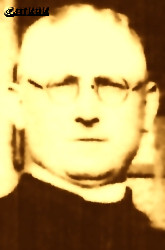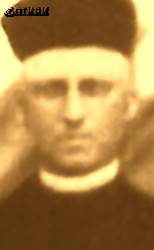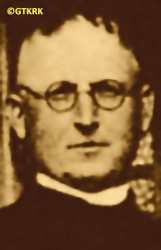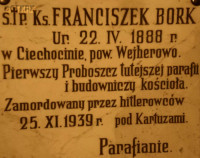Roman Catholic
St Sigismund parish
05-507 Słomczyn
85 Wiślana Str.
Konstancin deanery
Warsaw archdiocese, Poland
full list:
displayClick to display full list

searchClick to search full list by categories
wyświetlKliknij by wyświetlić pełną listę po polsku

szukajKliknij by przeszukać listę wg kategorii po polsku

Martyrology of the clergy — Poland
XX century (1914 – 1989)
personal data
surname
BORK
forename(s)
Francis Anthony (pl. Franciszek Antoni)
function
diocesan priest
creed
Latin (Roman Catholic) Church RCmore on
en.wikipedia.org
[access: 2014.09.21]
diocese / province
Culm (Chełmno) diocesemore on
pl.wikipedia.org
[access: 2012.11.23]
honorary titles
„Polonia Restituta” Cross — 4th Class, Officer'smore on
en.wikipedia.org
[access: 2019.04.16]
(10.11.1927)
date and place
of death
25.11.1939

Kaliski foresttoday: Kartuzy gm., Kartuzy pov., Pomerania voiv., Poland
more on
en.wikipedia.org
[access: 2022.01.28]
alt. dates and places
of death
20.11.1939, 23.11.1939
details of death
During World War I 1914‐1918 drafted into German Imperial Army as a chaplain. From 23.11.1914 ministered in Hamerstein (Czarne) POW camp for Russian Imperial Army soldiers — mainly of Polish and Lithuanian nationality — where c. 12,000 perished and from 16.07.1917 in a garrison hospital in Gdańsk.
After German and Russian invasion of Poland in 09.1939 and start of the World War II, after start of German occupation, arrested by the Germans in 10.1939.
Released.
In 11.1939 arrested again and jailed in Kartuzy prison.
Few days later, on the evening of 25.11.1939, taken with 7 (or 8) other priests to the execution site.
The arrests and genocidal murders — in the Kaliska Forest, c. 1.5 km north‐east of the centre of Kartuzy, around halfway to the village of Kaliska, which is part of the Kartuzy Forest complex surrounding Kartuzy — were carried out, as part of the Germ. «Intelligenzaktion» (Eng. Intelligence Action), i.e. the extermination of the Polish intelligentsia and the leadership classes of Pomerania, by the genocidal unit of the Germ. Volksdeutscher Selbstschutz (Eng. Self‐Defence of Ethnic Germans), whose members were Germ. Volksdeutsche (Eng. Ethnic Germans), i.e. representatives of the German minority in Poland from Kartuzy and the surrounding area. Supervisory functions were performed by the Germ. SS‐Wachsturmbann „Eimann” unit (Eng. „Eimann” Guard and Assault Unit), formed by the decree of the Senate of the Free City of Gdańsk on 03.07.1939, on the basis of the 36. SS‐Standarte (Eng. 36. SS Propaganda Unit) from Gdańsk, playing i.a. the role ofa militant orchestra, constituting part of the paramilitary, genocidal Germ. Die Schutzstaffel der NSDAP (Eng. NSDAP Protection Unit), i.e. «SS», subordinate to the National Socialist German Workers' Party NSDAP, commanded by a certain SS‐Obersturmbannführer Kurt Eimann.
The selection of convicts — from among those arrested on the basis of the so‐called Germ. Sonderfahndungsliste (Eng. Special Wanted List), i.e. a proscription list of names of „enemies of the Reich”, prepared before the German aggression, or on another proscription list, drawn up ad hoc on the basis of denunciations from local Germ. Volksdeutsche, were carried out by two commissions: the first one consisting of local commanders of the Germ. Volksdeutscher Selbstschutz and the Germ. Ordnungspolizei (Eng. Order Police), i.e. OrPo, a formation directly subordinated to the Germ. Chef der Deutschen Polizei (Eng. Chief of the German Police), the genocide master Heinrich Himmler; the second one, composed of the commanders of the Germ. Einsatzkommando 16 (Eng. Task Group 16), i.e. EK16, which was part of the Germ. Einsatzgruppen (Eng. Operational Groups), a formation of the Germ. Sicherheitspolizei (Eng. Security Police), i.e. SiPo, and the Germ. Sicherheitsdienst des Reichsführers SS (Eng. Security Service of the Reichsführer SS), i.e. SD, subordinate to the Germ. Reichssicherheitshauptamt (Eng. Reich Main Security Office), i.e. RSHA.
The victims — held in the court prison building in Kartuzy, several other makeshift detention centers in that city, as well as in the nearby Germ. „Internierungslager” (Eng. „internment camp”) IL Borowo — were transported to the crime scene prob. in wagons of railway line No. 229, the route of which runs through the Kaliska Forest.
The executed victims were often brutalized, having their limbs broken and their bodies finished off with shovels and rifle butts.
In total, the Germans murdered c. 200 residents of Kartuzy and the surrounding area, including 11 Catholic priests — i.a. 77 in a mass execution on 27.10.1939, and 39 in an execution on 25.11.1939.
In one of the surviving registers, next to the names of the priests, the Germans noted, as always, very precisely: Germ. „Auf dem Wege zwischen Karthaus und Danzig verschollen” (Eng. „Disappeared on the way between Kartuzy and Gdańsk”).
At the end of the war, in 1944/1945, as the German‐Russian front approached, as part of the Germ. „Sonderaktion 1005” (Eng. „Special Action 1005”) — using groups of prisoners known as Germ. „Leichenkommandos” (Eng. „Corpses' Units”) — the Germans dug up and burned most of the bodies.
cause of death
mass murder
perpetrators
Germans
sites and events
Kaliski forestClick to display the description, KartuzyClick to display the description, «Intelligenzaktion»Click to display the description, Reichsgau Danzig‐WestpreußenClick to display the description, Ribbentrop‐MolotovClick to display the description, Pius XI's encyclicalsClick to display the description
date and place
of birth
22.04.1888Birth certification on:
metryki.genbaza.pl
[access: 2025.11.10]

Ciechocinotoday: district of Reda, Reda urban gm., Wejherowo pov., Pomerania voiv., Poland
more on
en.wikipedia.org
[access: 2022.01.28]
parents
BORK Francis
🞲 ?, ? — 🕆 ?, ?

BRADTKE Matilde
🞲 ?, ? — 🕆 ?, ?
presbyter (holy orders)
ordination
29.03.1914

Pelplintoday: Pelplin gm., Tczew pov., Pomerania voiv., Poland
more on
en.wikipedia.org
[access: 2021.05.06]
Assumption of the Blessed Virgin Mary RC cathedral churchmore on
en.wikipedia.org
[access: 2025.03.14]
positions held
1928 – 1939
parish priest — Pomieczynotoday: Przodkowo gm., Kartuzy pov., Pomerania voiv., Poland
more on
en.wikipedia.org
[access: 2022.02.15] ⋄ St Joseph RC parish ⋄ Żukowotoday: Żukowo gm., Kartuzy pov., Pomerania voiv., Poland
more on
en.wikipedia.org
[access: 2021.09.02] RC deanery
1925 – 1928
curatus/rector/expositus — Pomieczynotoday: Przodkowo gm., Kartuzy pov., Pomerania voiv., Poland
more on
en.wikipedia.org
[access: 2022.02.15] ⋄ St Joseph RC church ⋄ Przodkowotoday: Przodkowo gm., Kartuzy pov., Pomerania voiv., Poland
more on
en.wikipedia.org
[access: 2021.09.02], St Andrew the Apostle RC parish ⋄ Żukowotoday: Żukowo gm., Kartuzy pov., Pomerania voiv., Poland
more on
en.wikipedia.org
[access: 2021.09.02] RC deanery
till 1925
vicar — Zblewotoday: Zblewo gm., Starogard Gdański pov., Pomerania voiv., Poland
more on
en.wikipedia.org
[access: 2021.09.02] ⋄ St Michael the Archangel RC parish ⋄ Starogard Gdańskitoday: Starogard Gdański gm., Starogard Gdański pov., Pomerania voiv., Poland
more on
en.wikipedia.org
[access: 2021.06.07] RC deanery
vicar — Barłożnotoday: Skórcz gm., Starogard Gdański pov., Pomerania voiv., Poland
more on
en.wikipedia.org
[access: 2021.09.02] ⋄ St Martin the Bishop and Confessor RC parish ⋄ Nowealso: Nowe nad Wisłą
today: Nowe gm., Świecie pov., Kuyavia‐Pomerania voiv., Poland
more on
en.wikipedia.org
[access: 2020.11.27] RC deanery
vicar — Wudzyntoday: Dobrcz gm., Bydgoszcz pov., Kuyavia‐Pomerania voiv., Poland
more on
en.wikipedia.org
[access: 2021.09.02] ⋄ St Barbara the Virgin and Martyr RC parish ⋄ Fordontoday: district of Bydgoszcz, Bydgoszcz city pov., Kuyavia‐Pomerania voiv., Poland
more on
en.wikipedia.org
[access: 2021.09.02] RC deanery
from 1919
vicar — Papowo Toruńskietoday: Łysomice gm., Toruń pov., Kuyavia‐Pomerania voiv., Poland
more on
en.wikipedia.org
[access: 2021.12.18] ⋄ St Nicholas the Bishop and Confessor RC parish ⋄ Toruńtoday: Toruń city pov., Kuyavia‐Pomerania voiv., Poland
more on
en.wikipedia.org
[access: 2021.06.20] RC deanery
from 1914
vicar — Czarnylastoday: Skórcz gm., Starogard Gdański pov., Pomerania voiv., Poland
more on
en.wikipedia.org
[access: 2021.09.02] ⋄ St Andrew the Apostle RC parish ⋄ Gniewtoday: Gniew gm., Tczew pov., Pomerania voiv., Poland
more on
en.wikipedia.org
[access: 2021.07.29] RC deanery
1917 – 1918
chaplain — Gdańsktoday: Gdańsk city pov., Pomerania voiv., Poland
more on
en.wikipedia.org
[access: 2021.07.04] ⋄ garrison hospital, German Imperial Army — also: paramedic
1914 – 1917
chaplain — Czarneform.: Hammerstein
today: Czarne gm., Człuchów pov., Pomerania voiv., Poland
more on
en.wikipedia.org
[access: 2010.08.11] ⋄ POW camp, German Imperial Army — among POWs from the Russian Imperial Army, mainly of Polish and Lithuanian nationality; also: paramedic
1910 – 1914
student — Pelplintoday: Pelplin gm., Tczew pov., Pomerania voiv., Poland
more on
en.wikipedia.org
[access: 2021.05.06] ⋄ philosophy and theology, Theological Seminary
1900 – 1910
pupil — Wejherowotoday: Wejherowo gm., Wejherowo pov., Pomerania voiv., Poland
more on
en.wikipedia.org
[access: 2021.09.02] ⋄ Germ. Königliche Gymnasium (Eng. Royal Gymnasium) — studies crowned with the maturity diploma (i.e. matura)
others related
in death
ARASMUSClick to display biography Anthony, FROSTClick to display biography Silvester Francis, GBUREKClick to display biography Alex Francis, GOŁOMSKIClick to display biography Bernard, KLONOWSKIClick to display biography Felix, KRZEWIŃSKIClick to display biography Maximilian, KUCAClick to display biography Vaclav, MOTYLEWSKIClick to display biography Francis Xavier, ROSIAKClick to display biography Louis, SZUTAClick to display biography Bernard, ZAPAŁOWSKIClick to display biography Thaddeus Marian
sites and events
descriptions
Kaliski forest: In Kartuzy forests — Kaliska forests are part of them — during the extermination of Polish intelligentsia in Pomeranian voivodship, called «Intelligenzaktion» — from 09.1939 till 11.1939 Germans murdered approx. 200 inhabitants of Kartuzy and surrounding villages, including 11 Catholic priests. Some of the victims were tortured and finished off with blows of gun butts and shovels. Most of the bodies at the end of the war, in 1944/1945, due to the approach of the German‐Russian front, as part of the Germ. „Sonderaktion 1005” (Eng. „Special Action 1005”) — using groups of prisoners known as the Germ. „Leichenkommandos” (Eng. „Corpse Units”) — the Germans dug up the bodies of the murdered and then burned them. (more on: pl.wikipedia.orgClick to attempt to display webpage
[access: 2012.11.23])
Kartuzy: Detention centre run by Germans. (more on: pl.wikipedia.orgClick to attempt to display webpage
[access: 2012.11.23])
«Intelligenzaktion»: German: «Intelligenzaktion» (English: „Intelligence Action”) — a German program of extermination of the Polish elite, mainly the intelligentsia and leadership layers, carried out from the beginning of the occupation in w 09.1939 to 04.1940, mainly in territories directly annexed to Germany, but also in the so‐called Germ. Generalgouvernement (Eng. General Governorate), where it was called «AB‐aktion». In the first phase, immediately after the beginning of the German occupation, during military operations carried out by the Germ. Wehrmacht (Eng. Armed Forces) and the genocidal units of the Germ. Einsatzgruppen (Eng. Operational Groups) of the Germ. Sicherheitspolizei (Eng. Security Police), i.e. SiPo, and Germ. Sicherheitsdienst des Reichsführers SS (Eng. Security Service of the Reichsführer SS), i.e. SD, organized by the Germ. Reichssicherheitshauptamt (Eng. Reich Main Security Office), i.e. RSHA, which followed the troops, carried out under the Germ. Unternehmen „Tannenberg” (Eng. Operation „Tannenberg”) — based on the so‐called Germ. Sonderfahndungsliste (Eng. Special Wanted Lists), i.e. proscription lists of Poles considered particularly dangerous to the Third Reich, prepared by the Zentralstelle II/P (Polen) unit of the German RSHA. Later, implemented by the German civilian occupation authorities and the genocidal unit of the Germ. Volksdeutscher Selbstschutz (Eng. Ethnic Germans Self‐Defense), whose members were Germ. Volksdeutsche (Eng. Ethnic Germans), i.e. representatives of the German minority in Poland. According to various sources, these lists, at the beginning of 09.1939, could have contained the details of 61,000—88,000 „dangerous” Poles — although these figures cannot be confirmed. In total, during this genocide, c. 50,000 teachers, Catholic priests, representatives of the landed gentry, freelancers, social and political activists, and retired military personnel were systematically and methodically murdered. Another 50,000 were sent to concentration camps, where only a negligible percentage survived. (more on: en.wikipedia.orgClick to attempt to display webpage
[access: 2014.10.04])
Reichsgau Danzig‐Westpreußen: After the Polish defeat in the 09.1939 campaign, which was the result of the Ribbentrop‐Molotov Pact and constituted the first stage of World War II, and the beginning of German occupation in part of Poland (in the other, eastern part of Poland, the Russian occupation began), the Germans divided the occupied Polish territory into five main regions (and a few smaller). The largest one was transformed into Germ. Generalgouvernement (Eng. General Governorate), intended exclusively for Poles and Jews and constituting part of the so‐called Germ. Großdeutschland (Eng. Greater Germany). Two were added to existing German provinces. From two other separate new provinces were created. Vistula Pomerania region was one of them, incorporated into Germany on 08.10.1939, by decree of the German leader Adolf Hitler (formally came into force on 26.10.1939), and on 02.11.1939 transformed into the Germ. Reichsgau Danzig‐Westpreußen (Eng. Reich District of Gdańsk‐West Prussia) province, in which the law of the German state was to apply. The main axis of the policy of the new province, the territory of which the Germans recognized as the Germ. „Ursprünglich Deutsche” (Eng. „natively German”), despite the fact that 85% of its inhabitants were Poles, was Germ. „Entpolonisierung” (Eng. „Depolonisation”), i.e. forced Germanization. C. 60,000 Poles were murdered in 1939‐1940, as part of the Germ. „Intelligenzaktion”, i.e. extermination of Polish intelligentsia and ruling classes, in c. 432 places of mass executions — including c. 220 Polish Catholic priests. The same number were sent to German concentration camps, from where few returned (over 300 priests were arrested, of whom c. 130 died in concentration camps). C. 124,000‐170,000 were displaced, including c. 90,000 to the Germ. Generalgouvernement. Poles were forced en masse to sign the German nationality list, the Germ. Deutsche Volksliste DVL. Polish children could only learn in German. It was forbidden to use the Polish language during Catholic Holy Masses and during confession. Polish landed estates were confiscated..To further reduce the number of the Polish population, Poles were sent to forced labor deep inside Germany. The remaining Poles were treated as low‐skilled labor, isolated from the Germans and strictly controlled — legally, three or three of them could only meet together, even in their own apartments. Many were conscripted into the German Wehrmacht army. After the end of hostilities of World War II, the overseer of this province, the Germ. Reichsstatthalter (Eng. Reich Governor) and the Germ. Gauleiter (Eng. district head) of the German National Socialist Party, Albert Maria Forster, was executed. (more on: en.wikipedia.orgClick to attempt to display webpage
[access: 2024.06.24])
Ribbentrop‐Molotov: Genocidal Russian‐German alliance pact between Russian leader Joseph Stalin and German leader Adolf Hitler signed on 23.08.1939 in Moscow by respective foreign ministers, Mr. Vyacheslav Molotov for Russia and Joachim von Ribbentrop for Germany. The pact sanctioned and was the direct cause of joint Russian and German invasion of Poland and the outbreak of the World War II in 09.1939. In a political sense, the pact was an attempt to restore the status quo ante before 1914, with one exception, namely the „commercial” exchange of the so‐called „Kingdom of Poland”, which in 1914 was part of the Russian Empire, fore Eastern Galicia (today's western Ukraine), in 1914 belonging to the Austro‐Hungarian Empire. Galicia, including Lviv, was to be taken over by the Russians, the „Kingdom of Poland” — under the name of the General Governorate — Germany. The resultant „war was one of the greatest calamities and dramas of humanity in history, for two atheistic and anti‐Christian ideologies — national and international socialism — rejected God and His fifth Decalogue commandment: Thou shall not kill!” (Abp Stanislav Gądecki, 01.09.2019). The decisions taken — backed up by the betrayal of the formal allies of Poland, France and Germany, which on 12.09.1939, at a joint conference in Abbeville, decided not to provide aid to attacked Poland and not to take military action against Germany (a clear breach of treaty obligations with Poland) — were on 28.09.1939 slightly altered and made more precise when a treaty on „German‐Russian boundaries and friendship” was agreed by the same murderous signatories. One of its findings was establishment of spheres of influence in Central and Eastern Europe and in consequence IV partition of Poland. In one of its secret annexes agreed, that: „the Signatories will not tolerate on its respective territories any Polish propaganda that affects the territory of the other Side. On their respective territories they will suppress all such propaganda and inform each other of the measures taken to accomplish it”. The agreements resulted in a series of meeting between two genocidal organization representing both sides — German Gestapo and Russian NKVD when coordination of efforts to exterminate Polish intelligentsia and Polish leading classes (in Germany called «Intelligenzaktion», in Russia took the form of Katyń massacres) where discussed. Resulted in deaths of hundreds of thousands of Polish intelligentsia, including thousands of priests presented here, and tens of millions of ordinary people,. The results of this Russian‐German pact lasted till 1989 and are still in evidence even today. (more on: en.wikipedia.orgClick to attempt to display webpage
[access: 2015.09.30])
Pius XI's encyclicals: Facing the creation of two totalitarian systems in Europe, which seemed to compete with each other, though there were more similarities than contradictions between them, Pope Pius XI issued in 03.1937 (within 5 days) two encyclicals. In the „Mit brennender Sorge” (Eng. „With Burning Concern”) published on 14.03.1938, condemned the national socialism prevailing in Germany. The Pope wrote: „Whoever, following the old Germanic‐pre‐Christian beliefs, puts various impersonal fate in the place of a personal God, denies the wisdom of God and Providence […], whoever exalts earthly values: race or nation, or state, or state system, representatives of state power or other fundamental values of human society, […] and makes them the highest standard of all values, including religious ones, and idolizes them, this one […] is far from true faith in God and from a worldview corresponding to such faith”. On 19.03.1937, published „Divini Redemptoris” (Eng. „Divine Redeemer”), in which criticized Russian communism, dialectical materialism and the class struggle theory. The Pope wrote: „Communism deprives man of freedom, and therefore the spiritual basis of all life norms. It deprives the human person of all his dignity and any moral support with which he could resist the onslaught of blind passions […] This is the new gospel that Bolshevik and godless communism preaches as a message of salvation and redemption of humanity”… Pius XI demanded that the established human law be subjected to the natural law of God , recommended the implementation of the ideal of a Christian state and society, and called on Catholics to resist. Two years later, National Socialist Germany and Communist Russia came together and started World War II. (more on: www.vatican.vaClick to attempt to display webpage
[access: 2023.05.28], www.vatican.vaClick to attempt to display webpage
[access: 2023.05.28])
sources
personal:
jerzyschroeder.bloog.plClick to attempt to display webpage
[access: 2012.11.23], www.gazetakartuska.plClick to attempt to display webpage
[access: 2013.10.05], metryki.genbaza.plClick to attempt to display webpage
[access: 2025.11.10]
bibliographical:
„Biographical dictionary of priests of the Chełmno diocese ordained in the years 1821‐1920”, Henry Mross, Pelplin, 1995
original images:
www.pinterest.co.ukClick to attempt to display webpage
[access: 2018.09.23], www.pinterest.co.krClick to attempt to display webpage
[access: 2018.09.23], archiwum.allegro.plClick to attempt to display webpage
[access: 2018.11.18], commons.wikimedia.orgClick to attempt to display webpage
[access: 2014.01.28]
LETTER to CUSTODIAN/ADMINISTRATOR
If you have an Email client on your communicator/computer — such as Mozilla Thunderbird, Windows Mail or Microsoft Outlook, described at WikipediaPatrz:
en.wikipedia.org, among others — try the link below, please:
LETTER to CUSTODIAN/ADMINISTRATORClick and try to call your own Email client
If however you do not run such a client or the above link is not active please send an email to the Custodian/Administrator using your account — in your customary email/correspondence engine — at the following address:

giving the following as the subject:
MARTYROLOGY: BORK Francis Anthony
To return to the biography press below:
 Click to return to biography
Click to return to biography












